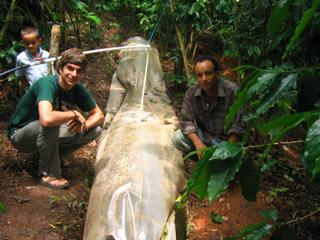I have no explanation to such questions or inquiries; however, from living here in Honduras for three years I have discovered that there exists a cheap alternative to living off the grid. The alternative I am talking about does not require lavishly setup solar panels nor towering windmills, but rather your own waste and organic matter from the kitchen. For those who have never heard the unfamiliar word biogas shouted in the local coffee house or never took a biochemistry class (myself alike), now is your chance! Biogas or flammable biological gas (think flatulence), is methane produced from the anaerobic digestion of organic matter such as feedstock or kitchen waste. In more cushy terms, biogas is produced via the decomposition of organic matter (i.e. feces, banana peels) by micro-organisms and methanogenic bacteria in environments absent of all oxygen (anaerobic). Unlike aerobic digestion (compost piles), anaerobic bacteria and micro-organisms only exert themselves when oxygen is absent; however, if oxygen does enter the vessel, our methanogenic friends will go on strike and refuse to continue breaking down the organic matter. When we have zero oxygen, what was last night’s dinner will become a mixture of approximately 80% methane, 19% carbon dioxide, and trace elements of hydrogen sulfide. Typically left untouched methane is an extremely volatile and hazardous greenhouse gas, yet, with anaerobic digestion we turn a once danger gas into a renewable fuel alternative that can fuel stoves, heat water, power lights, and run trains.
In regards to anaerobic digestion, we find that there exists various examples of its and biogas’s existence in the natural world. For example the bacteria responsible for biogas are found in the digestive track of ruminant animals like those Jersey cows you may see grazing in western Pennsylvania (that does not mean we can stick a hose in our cow’s rectum and produce electricity). Additionally we find anaerobic digestion or biogas being produced in the marshes of Florida or the numerous landfills that invigorate our landscape. However, biogas can also produced in artificial environments that mimic nature in an accelerated process. These artificial vessels or biodigestors are oxygen free environments that harbor the various bacteria and microorganisms necessary for biogas. For example the septic tank you may have buried in your yard has the potential of being a biogas producing biodigestor that feeds your kitchen or hot water heater with clean burning renewable energy. What many of us think of as a pathogen tainted cement container, is rather a generator in the making, an escape from being a tired consumer worried about OPEC’s latest price hikes.
In addition to the brown gold in our sewer systems and septic tanks, the organic waste slowly decomposing in our bacteria copious landfills is an untapped source of biogas. On a daily basis landfills are producing massive quantities of methane that contribute to the destruction of the Ozone Layer; however, with proper technology and a vision for sustainability, an ecological disaster like Fresh Kills landfill can become an electricity generating plant. In the case of the megalopolis, São Paulo, Brazil, it did not take environmentalists long to see the potential of their trophy landfill Bandeirantes. Currently the landfill near São Paulo is generating an approximate 20 mW of electricity being supplied to over 400,000 households in the area. No longer would you look at Fresh Kills landfill and think of its dire pong, and congregations of vultures and seagulls, but conversely as a renewable alternative to coal or oil.
Although the U.S. Department of Energy and EPA have realized the potency of landfill gas (LFG), biogas still remains an obscure term in the debate for renewable energy. How is it that something purportedly used 3000 years ago in ancient Assyria to heat bath water is something we think of as an alternative to the energy crisis in “non-developed” nations? It is true that biogas is a more popular alternative in developing nations than in our own backyard, however, how can farms and swine factories continue to deny the beauty of biogas. Rather than spend hundreds of millions on the research and development of fusion power, governments and agencies can be spending a quarter of that on construction of household biodigestors that would utilize urine and feces, along with organic kitchen waste to produce biogas. The future of cheap renewable energy lies not in a laboratory at UC Berkeley, but in contrast within our own homes and toilets.
Stay tuned next month for more insightful information on biogas and how you can construct your own biodigestor for $200, and additional topics such as permaculture and its green revolution. For additional information, inquiries, solicitations, please contact Garbage Collector.
--
If you missed this month's earlier guest columns, check them out now:
Dave Gray's Aviation Monthly
The Miseducation of Kevo





